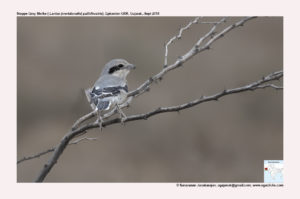Steppe Grey Shrike

Steppe Grey Shrike Lanius meridionalis pallidirostris
Etymology:
- Lanius : Latin word for Butcher . They are known as ‘butcher-birds,’ from their habit of storing prey by impaling it on thorns and sharp twigs, giving the resemblance to a butcher’s slaughterhouse.
- Meridionalis : Latin word for south, southern derived from meridies-south
- Pallidirostris : Latin word pallidus- pallid , pale ; rostris-billed
Vernacular Names: Hindi: Dudiyalatora, Safedlatora, Badalatora, Sans: Bharat sit-bhasmalatushak, Pun: Chittalatora, Ben: Kachkacha, Anjana, Ass: Chetcheti, Guj: Dudhio/Moto latora, Mar: Rakhikhatik, Te: Peddakiritigadu, Kasai pitta, Kan: Boodukalinga
Distribution in India: Winter visitor in East Rajasthan and parts of Gujarat in India.
Description: Size of 24–25 cm; wt. of 48–81 g. It is a rather large shrike with medium-length tail; white of scapulars, wing and tail conspicuous in flight. The male of nominate race has narrow black mask that is a thin dark area above bill barely noticeable extending to rear of ear-coverts, thin whitish supercilium which is often indistinct or lacking. The top of head, nape and upperparts to lower back are pale grey with variable bluish tinge. The rump and uppertail-coverts are often slightly paler, scapulars are white; upperwing is black, prominent white patch across bases of primaries, often anothernarrower white patch at base of secondaries, flight-feathers and tertials are tipped white. The tail is black, outer feather pair is white. The adjacent rectrices are with progressively decreasing amount of white; throat and underparts are white, in fresh plumage occasionally a hint of pink tinge on breast; irides are brown or dark brown; bill is black; legs are blackish. The female is like male but has less white in plumage; white wing patches are slightly smaller; whitish tips of wing feathers narrower, scapulars are with more grey tones, greyer underparts sometimes with hint of vermiculation on upper breast. The malehas paler head, back without brown tones, significantly longer wing, longer tail and less black in outer rectrix than female, but body mass does not differ between the sexes. The juvenile is generally more brownish grey, usually faintly barred dark brown from nape to uppertail-coverts, with mask browner, greater coverts pale-tipped, whitish below, grey-brown wash on breast and flanks, narrowly vermiculated brown, bill brownish grey.
Habitat: It breeds in subarctic and temperate climates in open country with trees, bushes, fence posts and power lines. Suitable perches are provided by isolated trees, small groves, bushes, and also pylons, electric wires and fences. Habitats used in non-breeding areas similar to those when breeding, but meadows more important outside breeding season.
Food habits:It eats small vertebrates like Voles, small birds, shrews, lizards and frogs. It also eatslarge insects like beetles, grasshoppers and crickets, wasps and bees worms, snails and crayfish.Moths are caught at night taking advantage of streetlights. It also eats small fruits. It forages and perches alone, or partners feed in close proximity to each other. It uses sit-and-wait technique. It utilizes variety of lookout perches like wires, fence lines, and tree branches. It dives down onto prey on ground. Also often hovers in manner of a kestrel and, in case of Lepidoptera and birds, will pursue airborne prey. It can use cues from UV-reflecting vole scent marks to locate suitable hunting areas. It very frequently impales prey, although some individuals impale more regularly in larders than others. Prey transported in bill or feet, the birds sometimes transferring prey from bill to feet in flight. During mating period, males impaled more prey before mating than they did afterwards like it was a signalling function. During breeding stagesimpaling was used primarily as a means of storing food: distance from larders to nests decreased, more prey was stored in well-concealed sites, and larger proportion of stored food was consumed.
Breeding habits: They breed in Mar to May in Central Europe.They are strictly territorial breeder. The nest is built by both sexes. The nest is a well-made structure with loose foundation of twigs, grass, rootlets, string, etc., often with high proportion of green plants, lined with rootlets, feathers and hair, placed generally high above in fork or on lateral branch of tree orin dense shrub. They lay a clutch of 3–9 eggs. A replacements clutch is laid if previous clutch lost. The incubation is done mainly by female, fed on and off nest by male. The incubation period is 14–19 days. The chicks are brooded by female, fed initially mostly by male, later by both sexes more equally. The nestling period is 14–21 days. The young accompanied by parents for 3 weeks or more, leave natal territory usually 6–7 weeks after fledging.